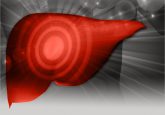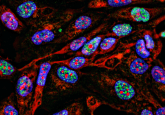Diagnosis with light
A*STAR researchers have developed a compact optical device that can detect biomarkers in urine rapidly and sensitively. The device could be used in the development of simple point-of-care diagnostics for cancer and other diseases.
A newly discovered class of short fragments of non-coding RNAs, known as microRNAs, have been found to be useful biomarkers for the diagnosis of various diseases, including cardiac disease and some cancers. Their detection is well suited to a rapid point-of-care method as they are surprisingly well preserved in fluids such as urine and blood.
Tiny changes in the phase of a light beam can be detected using a silicon photonic biosensor developed by Mi Kyoung Park (Principal Investigator, A*STAR Institute of Microelectronics) and her co-workers. The changes in light are caused by the hybridization of an immobilized DNA and target microRNAs in a sample.
A laser beam travels through a waveguide which splits into a sensing arm, where the light interacts with the sample, and a reference arm. The separated light beams are then rejoined. The phase of light traveling in the sensing arm is altered when binding between the DNA probe and target microRNA occurs, whereas there is no change in the phase in the reference arm. By Monitoring the variation in the intensity of the output beam, the amount of target microRNA in the sample can be determined.
The device has many practical advantages, “Existing methods to detect microRNAs are time consuming and require cumbersome machines, which limit their usefulness in clinical settings. This inspired us to develop a simple and efficient point-of-care device for detecting microRNAs” commented Park. Additionally as the device is highly sensitive and does not require labelling or amplification’ results can be delivered in 15 minutes meaning patients do not have to return for their test results. Another advantage of the device is that potentially 16 targets can be detected in one test.
To show the system worked Park and her team analyzed microRNAs in urine samples from three patients with late-stage bladder, the tests, which took 15 minutes, involved a single reaction. There was a marked difference between the microRNA levels of the patients and those of the two healthy subjects.
The researchers believe the device has great potential, “The system can be expanded to detect a number of microRNAs of different species and should be useful for a variety of point-of-care clinical applications,” noted Park.
Sources: A light diagnosis; Liu Q, Shin Y, Kee JS, et al. Mach–Zehnder interferometer (MZI) point-of-care system for rapid multiplexed detection of microRNAs in human urine specimens. Biosensors and Bioelectronics 71, 365–372 (2015); Liu Q, Tu X, Kim KW, et al. Highly sensitive Mach–Zehnder interferometer biosensor based on silicon nitride slot waveguide. Sensors and Actuators B: Chemical 188, 681–688 (2013).






